Leadership Challenges at Forest View Healthcare: A Detailed Report
VerifiedAdded on 2023/01/04
|19
|4923
|60
Report
AI Summary
This report analyzes the leadership challenges at Forest View Healthcare, a private aged care facility facing issues of staff and consumer dissatisfaction, and a rise in healthcare-related incidents, stemming from poor leadership and organizational culture. The report investigates the effects of poor leadership, including deviation from organizational vision, a gap between execution and strategy, the establishment of a mediocrity culture, and negative implications for the entire organization. It examines the impacts on staff (low morale, high turnover), customers (patient dissatisfaction), and the organization (reduced productivity, profits, and potential business failure). The report proposes solutions like transparent communication, breaking down silos, fostering open-mindedness, and establishing a solid foundational strategy to improve leadership effectiveness and organizational outcomes, supporting effective leadership and improving the quality of care.
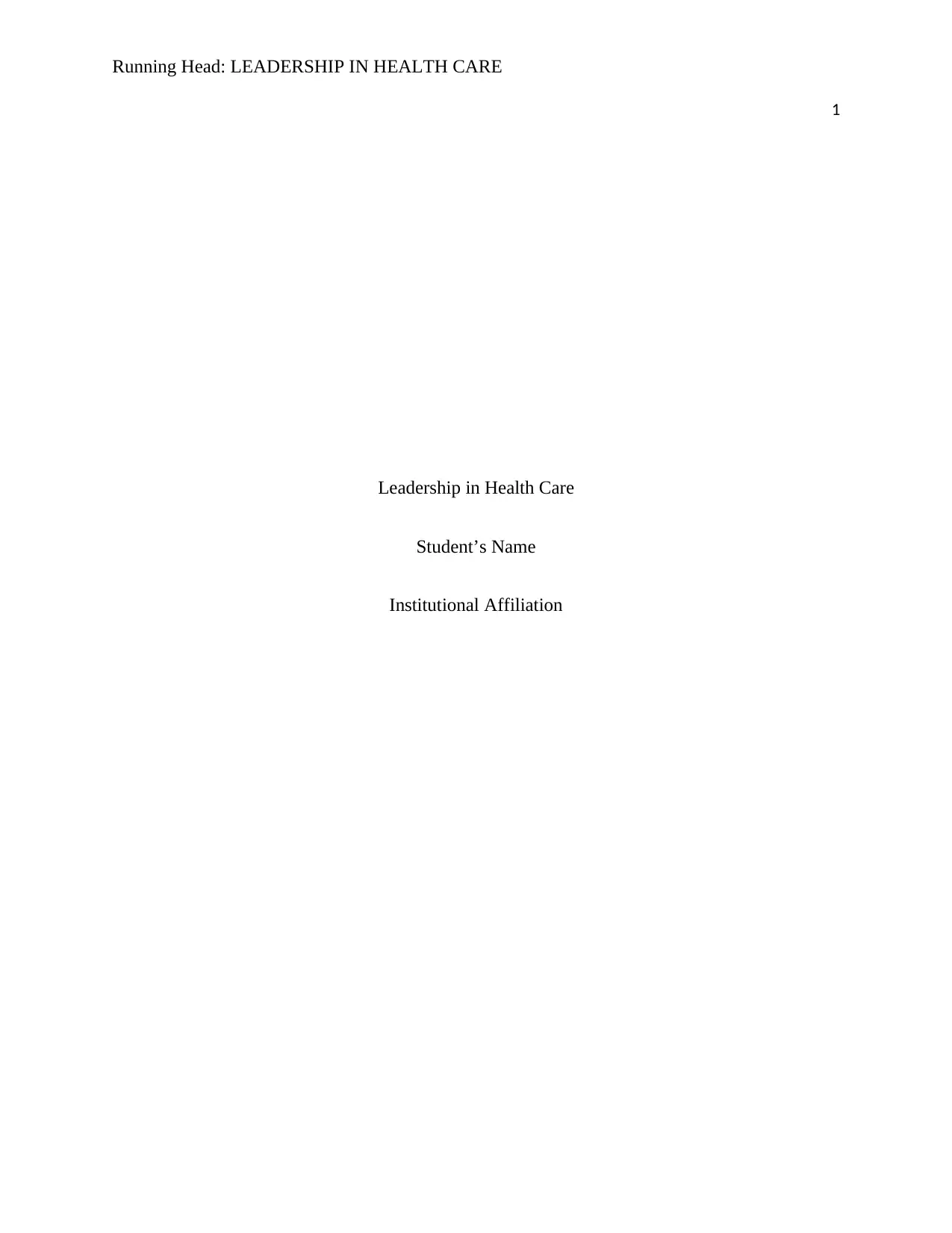
Running Head: LEADERSHIP IN HEALTH CARE
1
Leadership in Health Care
Student’s Name
Institutional Affiliation
1
Leadership in Health Care
Student’s Name
Institutional Affiliation
Paraphrase This Document
Need a fresh take? Get an instant paraphrase of this document with our AI Paraphraser
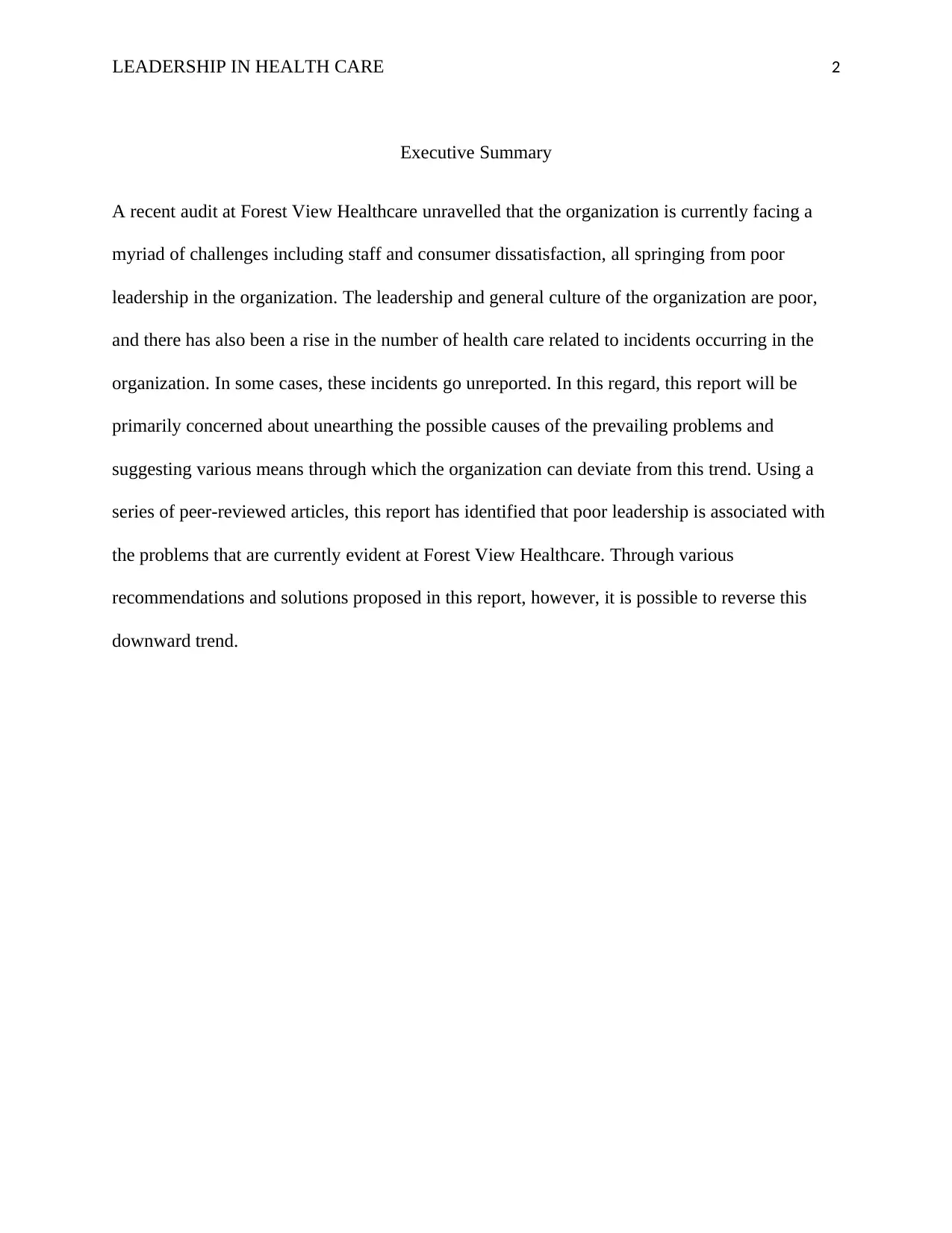
LEADERSHIP IN HEALTH CARE 2
Executive Summary
A recent audit at Forest View Healthcare unravelled that the organization is currently facing a
myriad of challenges including staff and consumer dissatisfaction, all springing from poor
leadership in the organization. The leadership and general culture of the organization are poor,
and there has also been a rise in the number of health care related to incidents occurring in the
organization. In some cases, these incidents go unreported. In this regard, this report will be
primarily concerned about unearthing the possible causes of the prevailing problems and
suggesting various means through which the organization can deviate from this trend. Using a
series of peer-reviewed articles, this report has identified that poor leadership is associated with
the problems that are currently evident at Forest View Healthcare. Through various
recommendations and solutions proposed in this report, however, it is possible to reverse this
downward trend.
Executive Summary
A recent audit at Forest View Healthcare unravelled that the organization is currently facing a
myriad of challenges including staff and consumer dissatisfaction, all springing from poor
leadership in the organization. The leadership and general culture of the organization are poor,
and there has also been a rise in the number of health care related to incidents occurring in the
organization. In some cases, these incidents go unreported. In this regard, this report will be
primarily concerned about unearthing the possible causes of the prevailing problems and
suggesting various means through which the organization can deviate from this trend. Using a
series of peer-reviewed articles, this report has identified that poor leadership is associated with
the problems that are currently evident at Forest View Healthcare. Through various
recommendations and solutions proposed in this report, however, it is possible to reverse this
downward trend.
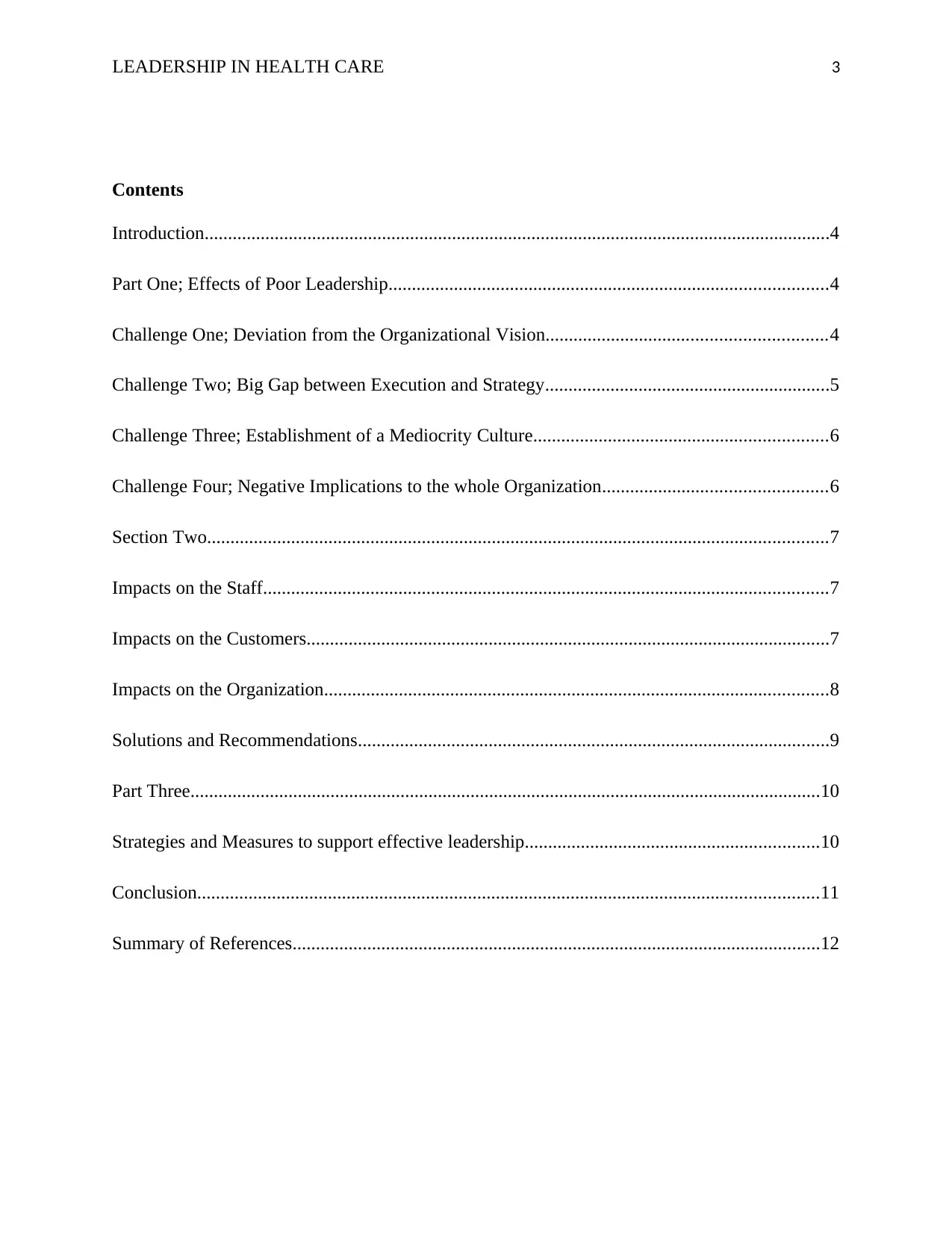
LEADERSHIP IN HEALTH CARE 3
Contents
Introduction......................................................................................................................................4
Part One; Effects of Poor Leadership..............................................................................................4
Challenge One; Deviation from the Organizational Vision............................................................4
Challenge Two; Big Gap between Execution and Strategy.............................................................5
Challenge Three; Establishment of a Mediocrity Culture...............................................................6
Challenge Four; Negative Implications to the whole Organization................................................6
Section Two.....................................................................................................................................7
Impacts on the Staff.........................................................................................................................7
Impacts on the Customers................................................................................................................7
Impacts on the Organization............................................................................................................8
Solutions and Recommendations.....................................................................................................9
Part Three.......................................................................................................................................10
Strategies and Measures to support effective leadership...............................................................10
Conclusion.....................................................................................................................................11
Summary of References.................................................................................................................12
Contents
Introduction......................................................................................................................................4
Part One; Effects of Poor Leadership..............................................................................................4
Challenge One; Deviation from the Organizational Vision............................................................4
Challenge Two; Big Gap between Execution and Strategy.............................................................5
Challenge Three; Establishment of a Mediocrity Culture...............................................................6
Challenge Four; Negative Implications to the whole Organization................................................6
Section Two.....................................................................................................................................7
Impacts on the Staff.........................................................................................................................7
Impacts on the Customers................................................................................................................7
Impacts on the Organization............................................................................................................8
Solutions and Recommendations.....................................................................................................9
Part Three.......................................................................................................................................10
Strategies and Measures to support effective leadership...............................................................10
Conclusion.....................................................................................................................................11
Summary of References.................................................................................................................12
⊘ This is a preview!⊘
Do you want full access?
Subscribe today to unlock all pages.

Trusted by 1+ million students worldwide
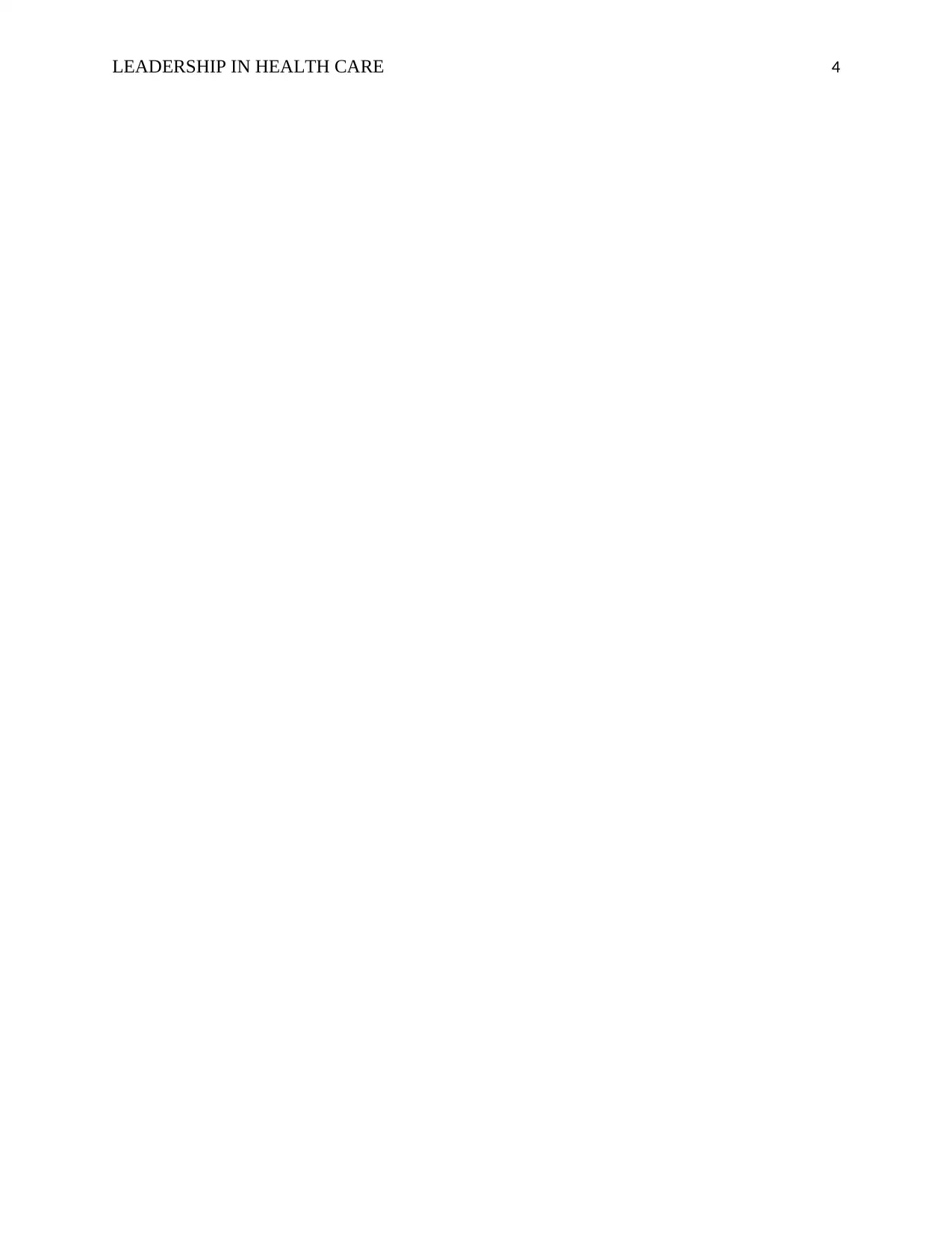
LEADERSHIP IN HEALTH CARE 4
Paraphrase This Document
Need a fresh take? Get an instant paraphrase of this document with our AI Paraphraser
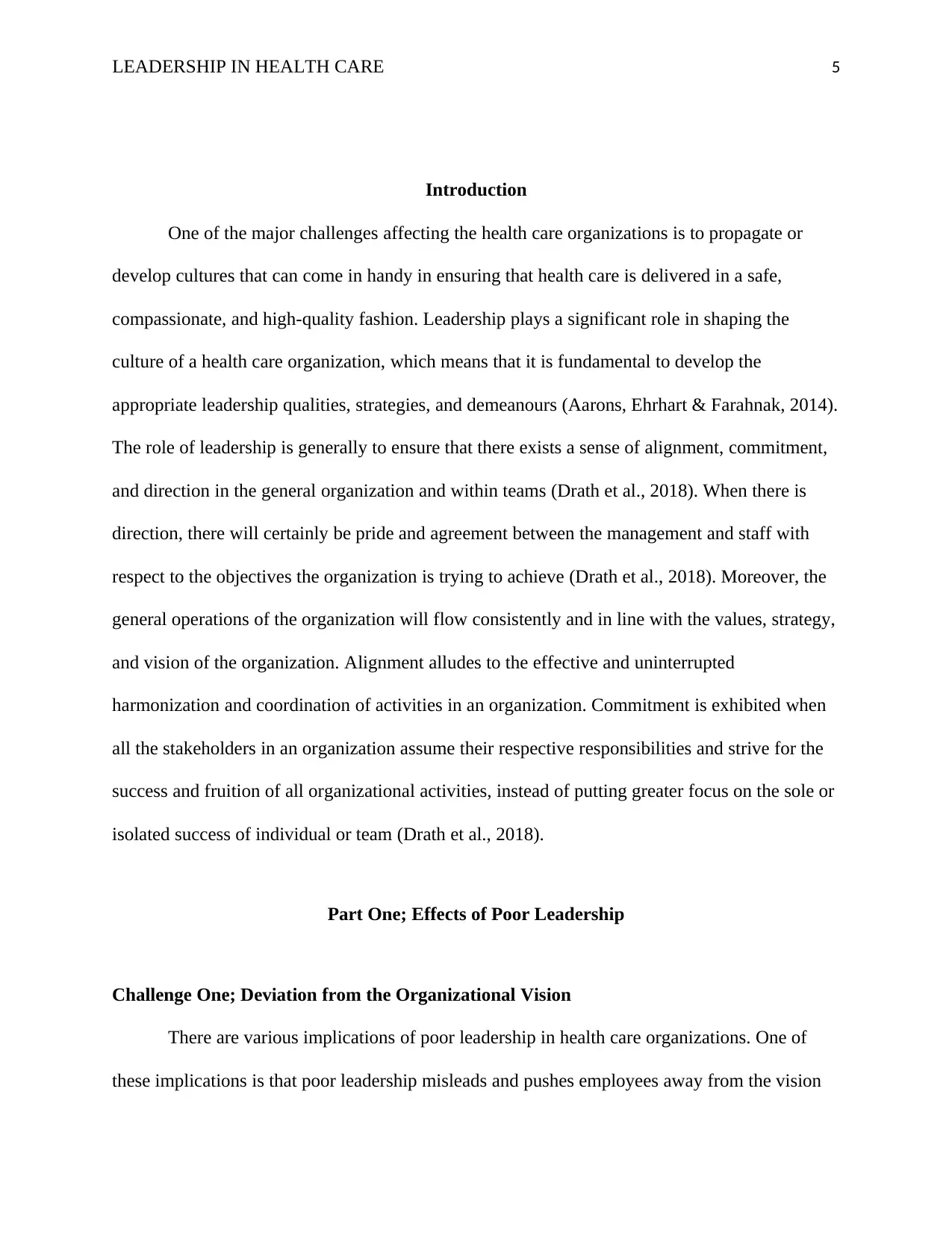
LEADERSHIP IN HEALTH CARE 5
Introduction
One of the major challenges affecting the health care organizations is to propagate or
develop cultures that can come in handy in ensuring that health care is delivered in a safe,
compassionate, and high-quality fashion. Leadership plays a significant role in shaping the
culture of a health care organization, which means that it is fundamental to develop the
appropriate leadership qualities, strategies, and demeanours (Aarons, Ehrhart & Farahnak, 2014).
The role of leadership is generally to ensure that there exists a sense of alignment, commitment,
and direction in the general organization and within teams (Drath et al., 2018). When there is
direction, there will certainly be pride and agreement between the management and staff with
respect to the objectives the organization is trying to achieve (Drath et al., 2018). Moreover, the
general operations of the organization will flow consistently and in line with the values, strategy,
and vision of the organization. Alignment alludes to the effective and uninterrupted
harmonization and coordination of activities in an organization. Commitment is exhibited when
all the stakeholders in an organization assume their respective responsibilities and strive for the
success and fruition of all organizational activities, instead of putting greater focus on the sole or
isolated success of individual or team (Drath et al., 2018).
Part One; Effects of Poor Leadership
Challenge One; Deviation from the Organizational Vision
There are various implications of poor leadership in health care organizations. One of
these implications is that poor leadership misleads and pushes employees away from the vision
Introduction
One of the major challenges affecting the health care organizations is to propagate or
develop cultures that can come in handy in ensuring that health care is delivered in a safe,
compassionate, and high-quality fashion. Leadership plays a significant role in shaping the
culture of a health care organization, which means that it is fundamental to develop the
appropriate leadership qualities, strategies, and demeanours (Aarons, Ehrhart & Farahnak, 2014).
The role of leadership is generally to ensure that there exists a sense of alignment, commitment,
and direction in the general organization and within teams (Drath et al., 2018). When there is
direction, there will certainly be pride and agreement between the management and staff with
respect to the objectives the organization is trying to achieve (Drath et al., 2018). Moreover, the
general operations of the organization will flow consistently and in line with the values, strategy,
and vision of the organization. Alignment alludes to the effective and uninterrupted
harmonization and coordination of activities in an organization. Commitment is exhibited when
all the stakeholders in an organization assume their respective responsibilities and strive for the
success and fruition of all organizational activities, instead of putting greater focus on the sole or
isolated success of individual or team (Drath et al., 2018).
Part One; Effects of Poor Leadership
Challenge One; Deviation from the Organizational Vision
There are various implications of poor leadership in health care organizations. One of
these implications is that poor leadership misleads and pushes employees away from the vision
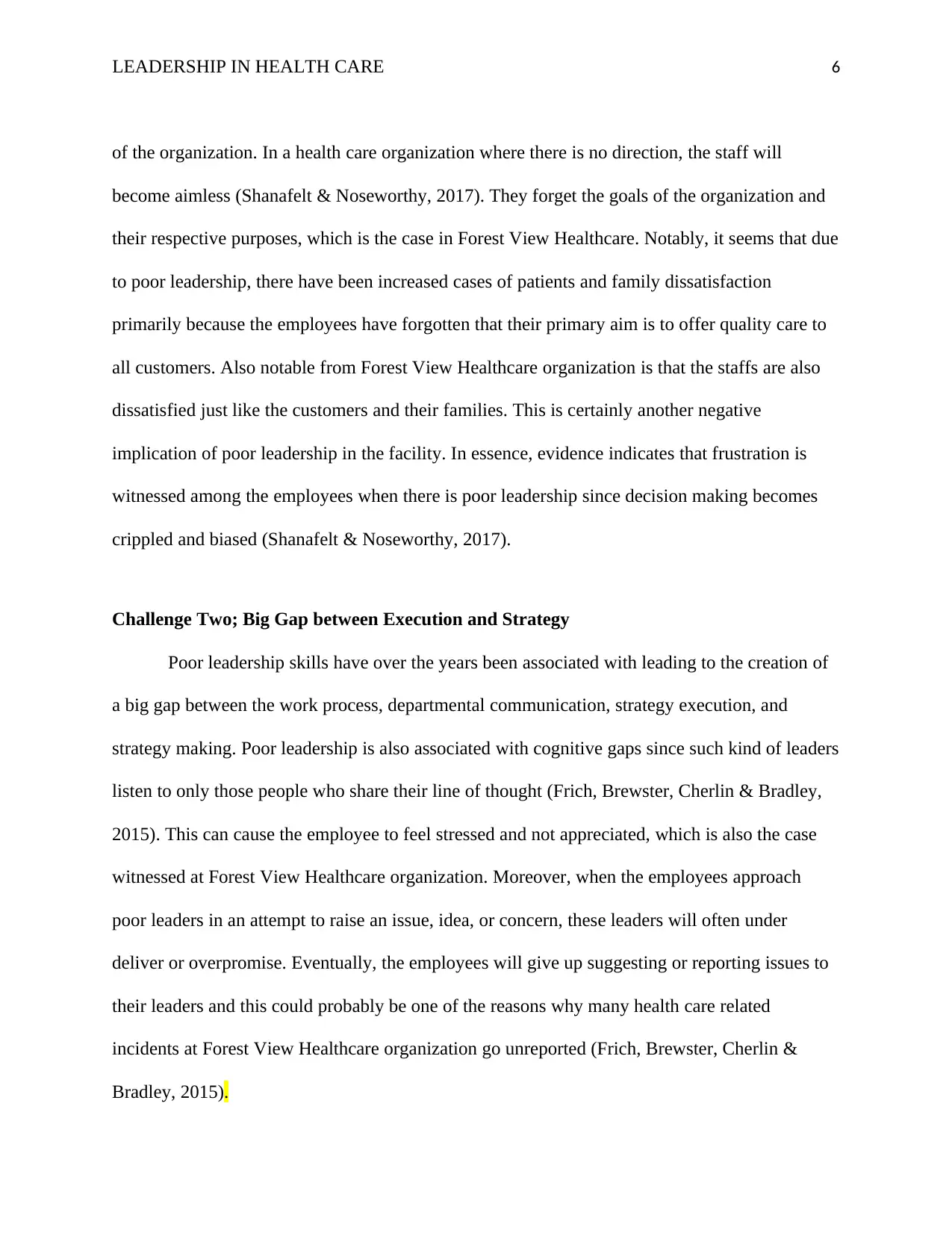
LEADERSHIP IN HEALTH CARE 6
of the organization. In a health care organization where there is no direction, the staff will
become aimless (Shanafelt & Noseworthy, 2017). They forget the goals of the organization and
their respective purposes, which is the case in Forest View Healthcare. Notably, it seems that due
to poor leadership, there have been increased cases of patients and family dissatisfaction
primarily because the employees have forgotten that their primary aim is to offer quality care to
all customers. Also notable from Forest View Healthcare organization is that the staffs are also
dissatisfied just like the customers and their families. This is certainly another negative
implication of poor leadership in the facility. In essence, evidence indicates that frustration is
witnessed among the employees when there is poor leadership since decision making becomes
crippled and biased (Shanafelt & Noseworthy, 2017).
Challenge Two; Big Gap between Execution and Strategy
Poor leadership skills have over the years been associated with leading to the creation of
a big gap between the work process, departmental communication, strategy execution, and
strategy making. Poor leadership is also associated with cognitive gaps since such kind of leaders
listen to only those people who share their line of thought (Frich, Brewster, Cherlin & Bradley,
2015). This can cause the employee to feel stressed and not appreciated, which is also the case
witnessed at Forest View Healthcare organization. Moreover, when the employees approach
poor leaders in an attempt to raise an issue, idea, or concern, these leaders will often under
deliver or overpromise. Eventually, the employees will give up suggesting or reporting issues to
their leaders and this could probably be one of the reasons why many health care related
incidents at Forest View Healthcare organization go unreported (Frich, Brewster, Cherlin &
Bradley, 2015).
of the organization. In a health care organization where there is no direction, the staff will
become aimless (Shanafelt & Noseworthy, 2017). They forget the goals of the organization and
their respective purposes, which is the case in Forest View Healthcare. Notably, it seems that due
to poor leadership, there have been increased cases of patients and family dissatisfaction
primarily because the employees have forgotten that their primary aim is to offer quality care to
all customers. Also notable from Forest View Healthcare organization is that the staffs are also
dissatisfied just like the customers and their families. This is certainly another negative
implication of poor leadership in the facility. In essence, evidence indicates that frustration is
witnessed among the employees when there is poor leadership since decision making becomes
crippled and biased (Shanafelt & Noseworthy, 2017).
Challenge Two; Big Gap between Execution and Strategy
Poor leadership skills have over the years been associated with leading to the creation of
a big gap between the work process, departmental communication, strategy execution, and
strategy making. Poor leadership is also associated with cognitive gaps since such kind of leaders
listen to only those people who share their line of thought (Frich, Brewster, Cherlin & Bradley,
2015). This can cause the employee to feel stressed and not appreciated, which is also the case
witnessed at Forest View Healthcare organization. Moreover, when the employees approach
poor leaders in an attempt to raise an issue, idea, or concern, these leaders will often under
deliver or overpromise. Eventually, the employees will give up suggesting or reporting issues to
their leaders and this could probably be one of the reasons why many health care related
incidents at Forest View Healthcare organization go unreported (Frich, Brewster, Cherlin &
Bradley, 2015).
⊘ This is a preview!⊘
Do you want full access?
Subscribe today to unlock all pages.

Trusted by 1+ million students worldwide
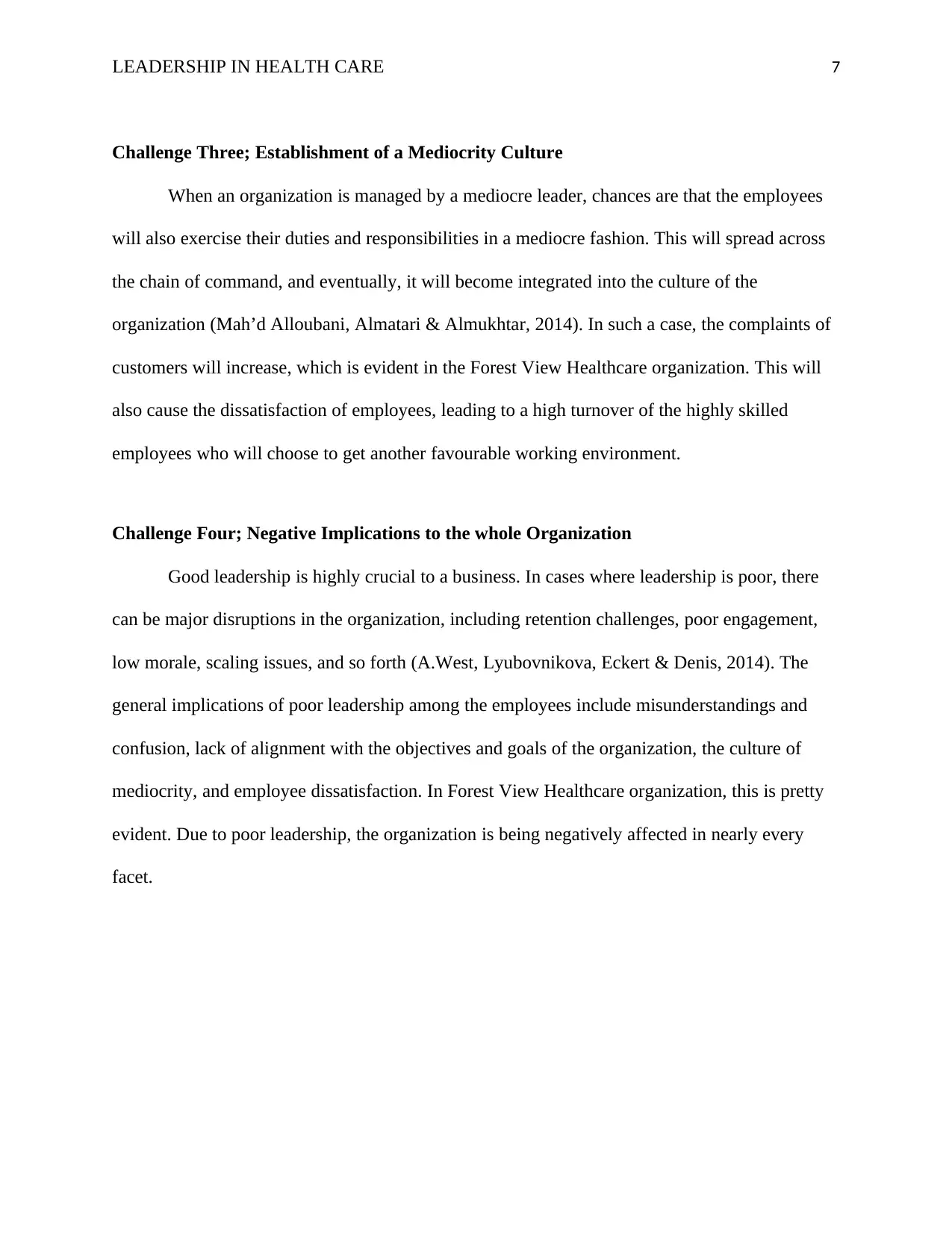
LEADERSHIP IN HEALTH CARE 7
Challenge Three; Establishment of a Mediocrity Culture
When an organization is managed by a mediocre leader, chances are that the employees
will also exercise their duties and responsibilities in a mediocre fashion. This will spread across
the chain of command, and eventually, it will become integrated into the culture of the
organization (Mah’d Alloubani, Almatari & Almukhtar, 2014). In such a case, the complaints of
customers will increase, which is evident in the Forest View Healthcare organization. This will
also cause the dissatisfaction of employees, leading to a high turnover of the highly skilled
employees who will choose to get another favourable working environment.
Challenge Four; Negative Implications to the whole Organization
Good leadership is highly crucial to a business. In cases where leadership is poor, there
can be major disruptions in the organization, including retention challenges, poor engagement,
low morale, scaling issues, and so forth (A.West, Lyubovnikova, Eckert & Denis, 2014). The
general implications of poor leadership among the employees include misunderstandings and
confusion, lack of alignment with the objectives and goals of the organization, the culture of
mediocrity, and employee dissatisfaction. In Forest View Healthcare organization, this is pretty
evident. Due to poor leadership, the organization is being negatively affected in nearly every
facet.
Challenge Three; Establishment of a Mediocrity Culture
When an organization is managed by a mediocre leader, chances are that the employees
will also exercise their duties and responsibilities in a mediocre fashion. This will spread across
the chain of command, and eventually, it will become integrated into the culture of the
organization (Mah’d Alloubani, Almatari & Almukhtar, 2014). In such a case, the complaints of
customers will increase, which is evident in the Forest View Healthcare organization. This will
also cause the dissatisfaction of employees, leading to a high turnover of the highly skilled
employees who will choose to get another favourable working environment.
Challenge Four; Negative Implications to the whole Organization
Good leadership is highly crucial to a business. In cases where leadership is poor, there
can be major disruptions in the organization, including retention challenges, poor engagement,
low morale, scaling issues, and so forth (A.West, Lyubovnikova, Eckert & Denis, 2014). The
general implications of poor leadership among the employees include misunderstandings and
confusion, lack of alignment with the objectives and goals of the organization, the culture of
mediocrity, and employee dissatisfaction. In Forest View Healthcare organization, this is pretty
evident. Due to poor leadership, the organization is being negatively affected in nearly every
facet.
Paraphrase This Document
Need a fresh take? Get an instant paraphrase of this document with our AI Paraphraser
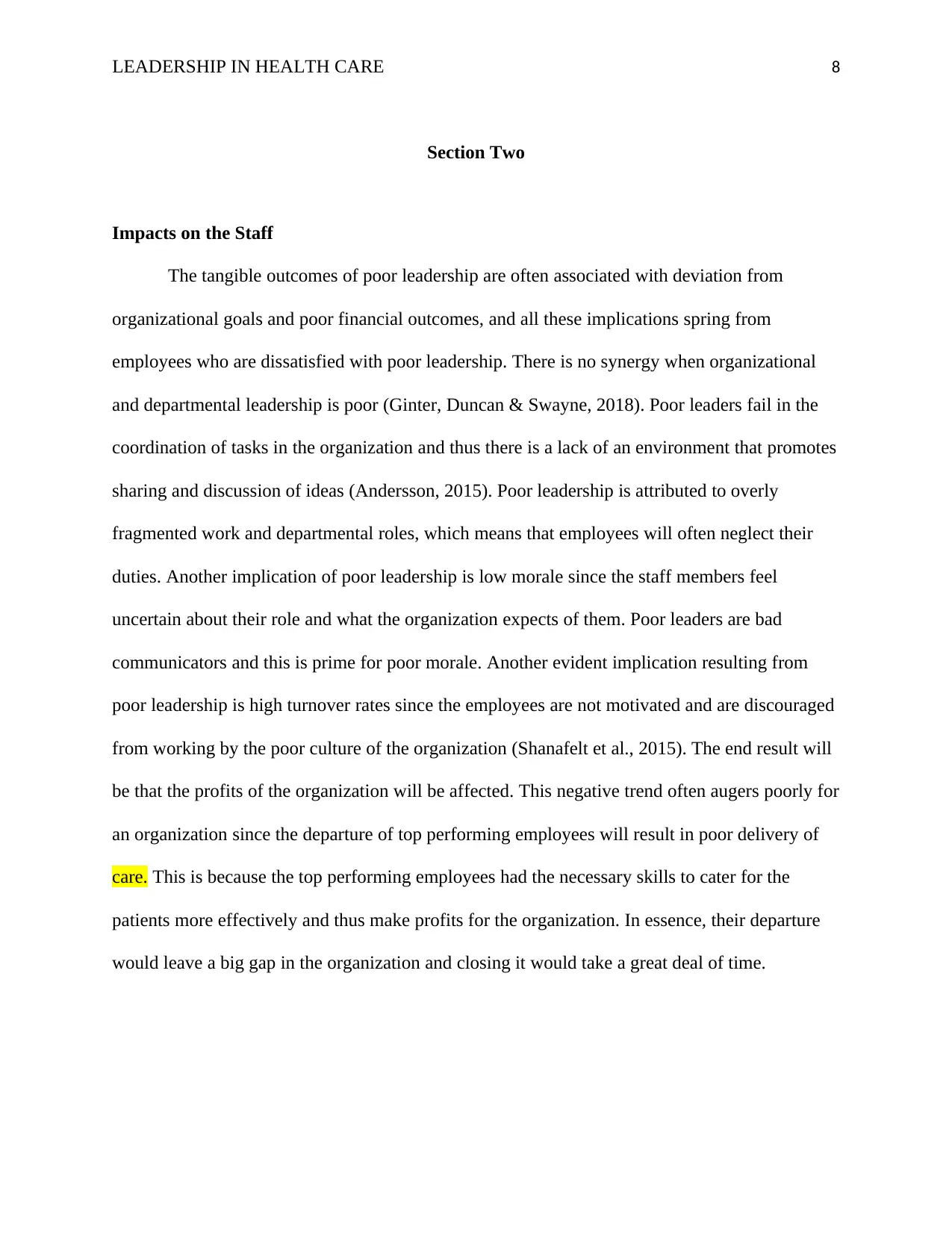
LEADERSHIP IN HEALTH CARE 8
Section Two
Impacts on the Staff
The tangible outcomes of poor leadership are often associated with deviation from
organizational goals and poor financial outcomes, and all these implications spring from
employees who are dissatisfied with poor leadership. There is no synergy when organizational
and departmental leadership is poor (Ginter, Duncan & Swayne, 2018). Poor leaders fail in the
coordination of tasks in the organization and thus there is a lack of an environment that promotes
sharing and discussion of ideas (Andersson, 2015). Poor leadership is attributed to overly
fragmented work and departmental roles, which means that employees will often neglect their
duties. Another implication of poor leadership is low morale since the staff members feel
uncertain about their role and what the organization expects of them. Poor leaders are bad
communicators and this is prime for poor morale. Another evident implication resulting from
poor leadership is high turnover rates since the employees are not motivated and are discouraged
from working by the poor culture of the organization (Shanafelt et al., 2015). The end result will
be that the profits of the organization will be affected. This negative trend often augers poorly for
an organization since the departure of top performing employees will result in poor delivery of
care. This is because the top performing employees had the necessary skills to cater for the
patients more effectively and thus make profits for the organization. In essence, their departure
would leave a big gap in the organization and closing it would take a great deal of time.
Section Two
Impacts on the Staff
The tangible outcomes of poor leadership are often associated with deviation from
organizational goals and poor financial outcomes, and all these implications spring from
employees who are dissatisfied with poor leadership. There is no synergy when organizational
and departmental leadership is poor (Ginter, Duncan & Swayne, 2018). Poor leaders fail in the
coordination of tasks in the organization and thus there is a lack of an environment that promotes
sharing and discussion of ideas (Andersson, 2015). Poor leadership is attributed to overly
fragmented work and departmental roles, which means that employees will often neglect their
duties. Another implication of poor leadership is low morale since the staff members feel
uncertain about their role and what the organization expects of them. Poor leaders are bad
communicators and this is prime for poor morale. Another evident implication resulting from
poor leadership is high turnover rates since the employees are not motivated and are discouraged
from working by the poor culture of the organization (Shanafelt et al., 2015). The end result will
be that the profits of the organization will be affected. This negative trend often augers poorly for
an organization since the departure of top performing employees will result in poor delivery of
care. This is because the top performing employees had the necessary skills to cater for the
patients more effectively and thus make profits for the organization. In essence, their departure
would leave a big gap in the organization and closing it would take a great deal of time.
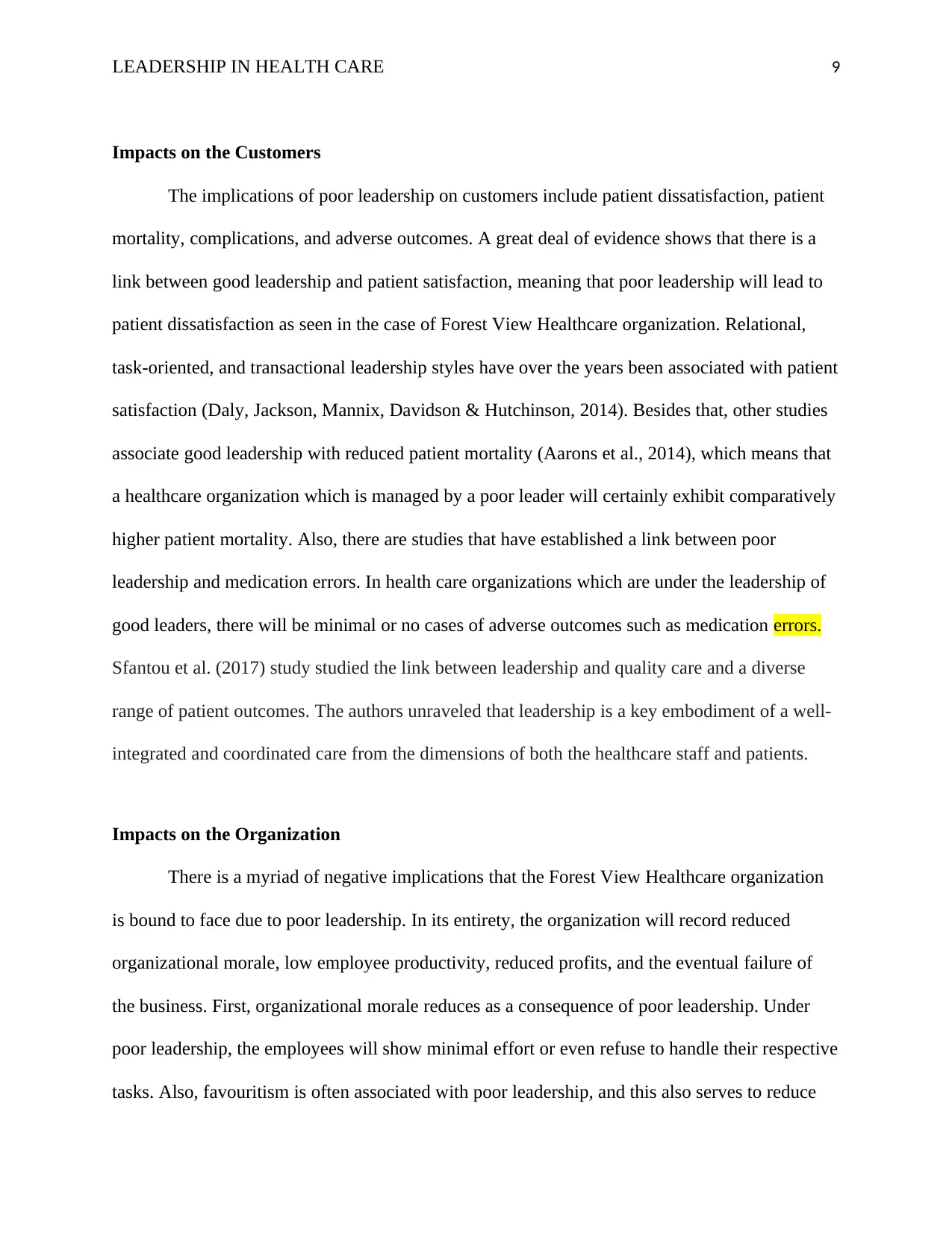
LEADERSHIP IN HEALTH CARE 9
Impacts on the Customers
The implications of poor leadership on customers include patient dissatisfaction, patient
mortality, complications, and adverse outcomes. A great deal of evidence shows that there is a
link between good leadership and patient satisfaction, meaning that poor leadership will lead to
patient dissatisfaction as seen in the case of Forest View Healthcare organization. Relational,
task-oriented, and transactional leadership styles have over the years been associated with patient
satisfaction (Daly, Jackson, Mannix, Davidson & Hutchinson, 2014). Besides that, other studies
associate good leadership with reduced patient mortality (Aarons et al., 2014), which means that
a healthcare organization which is managed by a poor leader will certainly exhibit comparatively
higher patient mortality. Also, there are studies that have established a link between poor
leadership and medication errors. In health care organizations which are under the leadership of
good leaders, there will be minimal or no cases of adverse outcomes such as medication errors.
Sfantou et al. (2017) study studied the link between leadership and quality care and a diverse
range of patient outcomes. The authors unraveled that leadership is a key embodiment of a well-
integrated and coordinated care from the dimensions of both the healthcare staff and patients.
Impacts on the Organization
There is a myriad of negative implications that the Forest View Healthcare organization
is bound to face due to poor leadership. In its entirety, the organization will record reduced
organizational morale, low employee productivity, reduced profits, and the eventual failure of
the business. First, organizational morale reduces as a consequence of poor leadership. Under
poor leadership, the employees will show minimal effort or even refuse to handle their respective
tasks. Also, favouritism is often associated with poor leadership, and this also serves to reduce
Impacts on the Customers
The implications of poor leadership on customers include patient dissatisfaction, patient
mortality, complications, and adverse outcomes. A great deal of evidence shows that there is a
link between good leadership and patient satisfaction, meaning that poor leadership will lead to
patient dissatisfaction as seen in the case of Forest View Healthcare organization. Relational,
task-oriented, and transactional leadership styles have over the years been associated with patient
satisfaction (Daly, Jackson, Mannix, Davidson & Hutchinson, 2014). Besides that, other studies
associate good leadership with reduced patient mortality (Aarons et al., 2014), which means that
a healthcare organization which is managed by a poor leader will certainly exhibit comparatively
higher patient mortality. Also, there are studies that have established a link between poor
leadership and medication errors. In health care organizations which are under the leadership of
good leaders, there will be minimal or no cases of adverse outcomes such as medication errors.
Sfantou et al. (2017) study studied the link between leadership and quality care and a diverse
range of patient outcomes. The authors unraveled that leadership is a key embodiment of a well-
integrated and coordinated care from the dimensions of both the healthcare staff and patients.
Impacts on the Organization
There is a myriad of negative implications that the Forest View Healthcare organization
is bound to face due to poor leadership. In its entirety, the organization will record reduced
organizational morale, low employee productivity, reduced profits, and the eventual failure of
the business. First, organizational morale reduces as a consequence of poor leadership. Under
poor leadership, the employees will show minimal effort or even refuse to handle their respective
tasks. Also, favouritism is often associated with poor leadership, and this also serves to reduce
⊘ This is a preview!⊘
Do you want full access?
Subscribe today to unlock all pages.

Trusted by 1+ million students worldwide
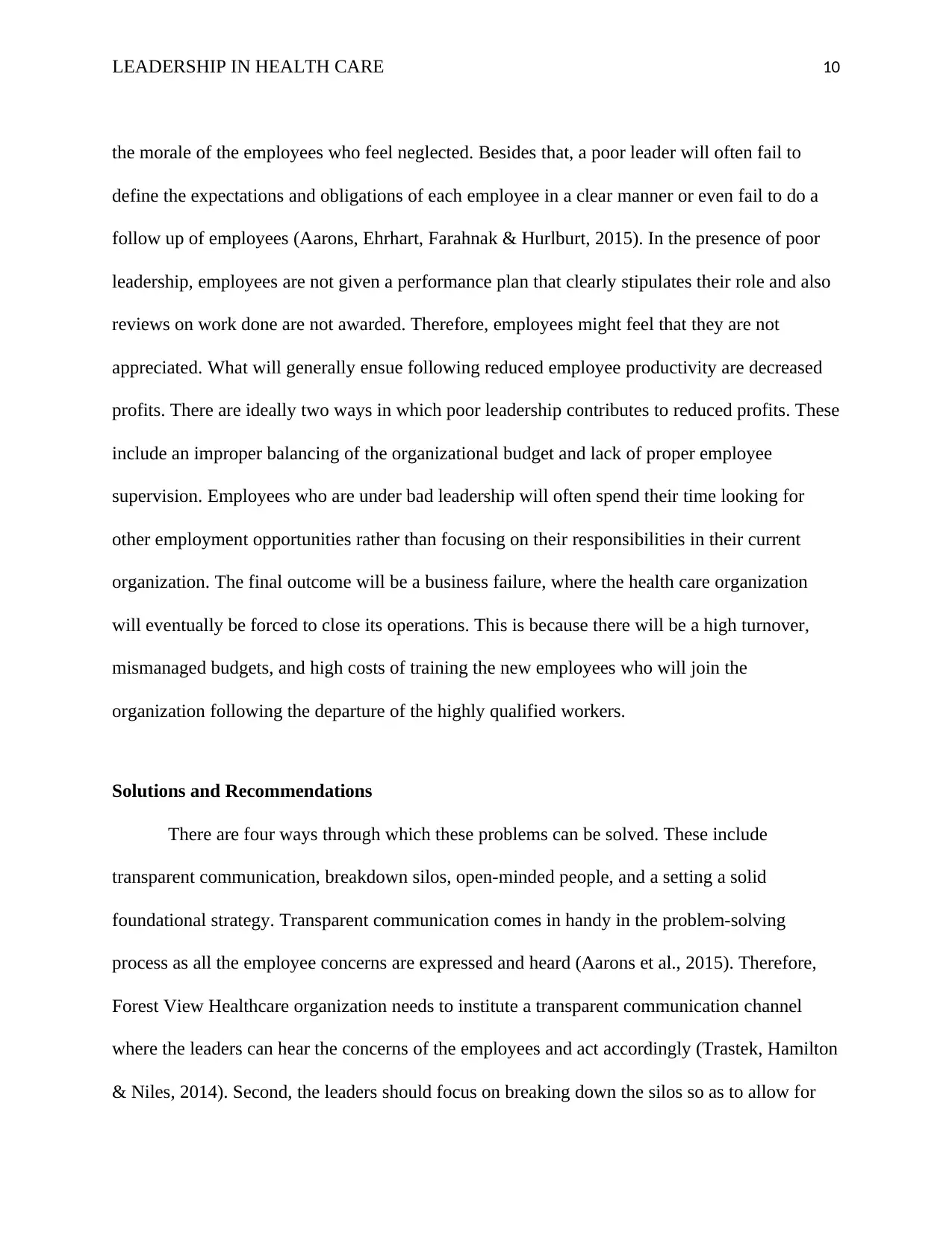
LEADERSHIP IN HEALTH CARE 10
the morale of the employees who feel neglected. Besides that, a poor leader will often fail to
define the expectations and obligations of each employee in a clear manner or even fail to do a
follow up of employees (Aarons, Ehrhart, Farahnak & Hurlburt, 2015). In the presence of poor
leadership, employees are not given a performance plan that clearly stipulates their role and also
reviews on work done are not awarded. Therefore, employees might feel that they are not
appreciated. What will generally ensue following reduced employee productivity are decreased
profits. There are ideally two ways in which poor leadership contributes to reduced profits. These
include an improper balancing of the organizational budget and lack of proper employee
supervision. Employees who are under bad leadership will often spend their time looking for
other employment opportunities rather than focusing on their responsibilities in their current
organization. The final outcome will be a business failure, where the health care organization
will eventually be forced to close its operations. This is because there will be a high turnover,
mismanaged budgets, and high costs of training the new employees who will join the
organization following the departure of the highly qualified workers.
Solutions and Recommendations
There are four ways through which these problems can be solved. These include
transparent communication, breakdown silos, open-minded people, and a setting a solid
foundational strategy. Transparent communication comes in handy in the problem-solving
process as all the employee concerns are expressed and heard (Aarons et al., 2015). Therefore,
Forest View Healthcare organization needs to institute a transparent communication channel
where the leaders can hear the concerns of the employees and act accordingly (Trastek, Hamilton
& Niles, 2014). Second, the leaders should focus on breaking down the silos so as to allow for
the morale of the employees who feel neglected. Besides that, a poor leader will often fail to
define the expectations and obligations of each employee in a clear manner or even fail to do a
follow up of employees (Aarons, Ehrhart, Farahnak & Hurlburt, 2015). In the presence of poor
leadership, employees are not given a performance plan that clearly stipulates their role and also
reviews on work done are not awarded. Therefore, employees might feel that they are not
appreciated. What will generally ensue following reduced employee productivity are decreased
profits. There are ideally two ways in which poor leadership contributes to reduced profits. These
include an improper balancing of the organizational budget and lack of proper employee
supervision. Employees who are under bad leadership will often spend their time looking for
other employment opportunities rather than focusing on their responsibilities in their current
organization. The final outcome will be a business failure, where the health care organization
will eventually be forced to close its operations. This is because there will be a high turnover,
mismanaged budgets, and high costs of training the new employees who will join the
organization following the departure of the highly qualified workers.
Solutions and Recommendations
There are four ways through which these problems can be solved. These include
transparent communication, breakdown silos, open-minded people, and a setting a solid
foundational strategy. Transparent communication comes in handy in the problem-solving
process as all the employee concerns are expressed and heard (Aarons et al., 2015). Therefore,
Forest View Healthcare organization needs to institute a transparent communication channel
where the leaders can hear the concerns of the employees and act accordingly (Trastek, Hamilton
& Niles, 2014). Second, the leaders should focus on breaking down the silos so as to allow for
Paraphrase This Document
Need a fresh take? Get an instant paraphrase of this document with our AI Paraphraser
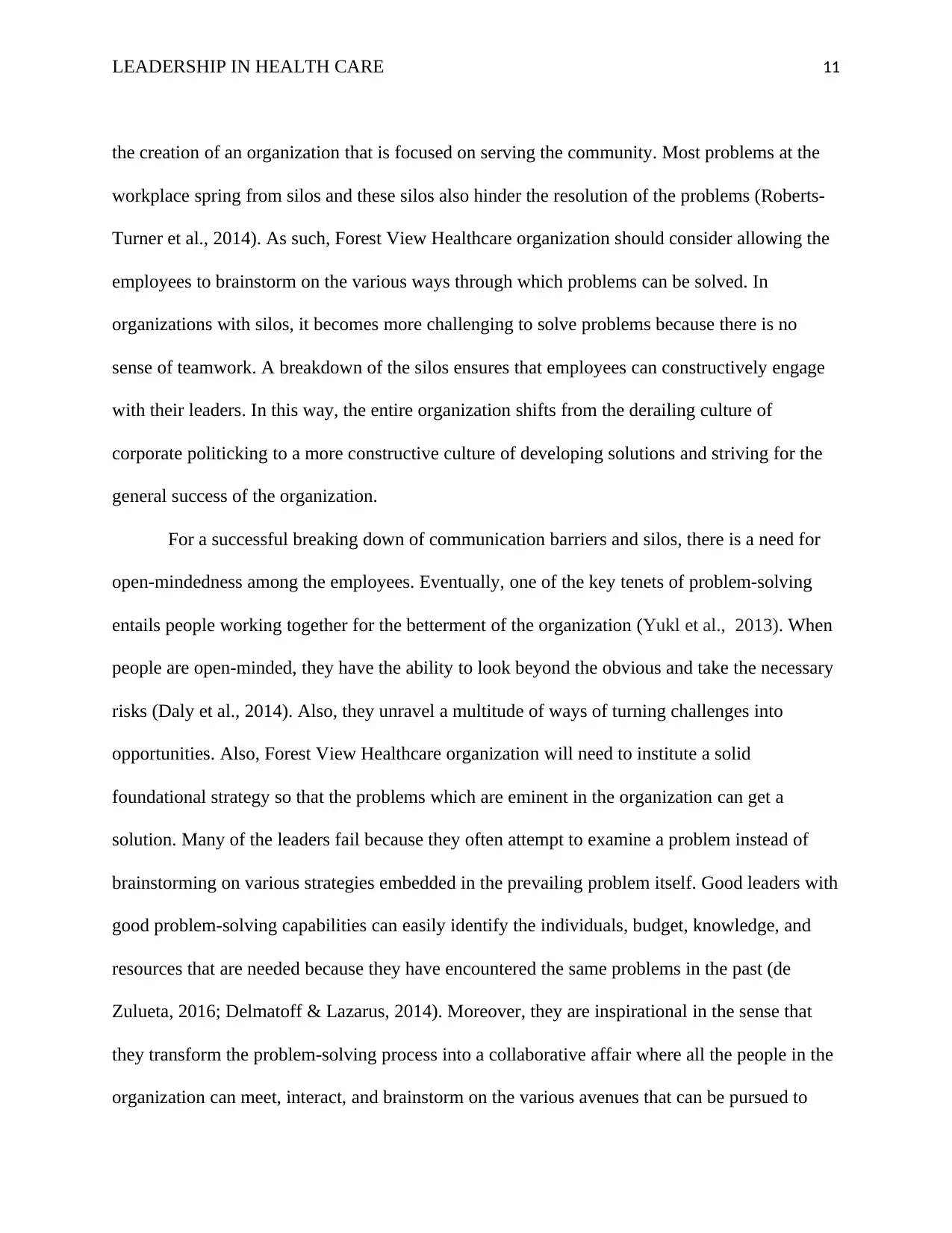
LEADERSHIP IN HEALTH CARE 11
the creation of an organization that is focused on serving the community. Most problems at the
workplace spring from silos and these silos also hinder the resolution of the problems (Roberts-
Turner et al., 2014). As such, Forest View Healthcare organization should consider allowing the
employees to brainstorm on the various ways through which problems can be solved. In
organizations with silos, it becomes more challenging to solve problems because there is no
sense of teamwork. A breakdown of the silos ensures that employees can constructively engage
with their leaders. In this way, the entire organization shifts from the derailing culture of
corporate politicking to a more constructive culture of developing solutions and striving for the
general success of the organization.
For a successful breaking down of communication barriers and silos, there is a need for
open-mindedness among the employees. Eventually, one of the key tenets of problem-solving
entails people working together for the betterment of the organization (Yukl et al., 2013). When
people are open-minded, they have the ability to look beyond the obvious and take the necessary
risks (Daly et al., 2014). Also, they unravel a multitude of ways of turning challenges into
opportunities. Also, Forest View Healthcare organization will need to institute a solid
foundational strategy so that the problems which are eminent in the organization can get a
solution. Many of the leaders fail because they often attempt to examine a problem instead of
brainstorming on various strategies embedded in the prevailing problem itself. Good leaders with
good problem-solving capabilities can easily identify the individuals, budget, knowledge, and
resources that are needed because they have encountered the same problems in the past (de
Zulueta, 2016; Delmatoff & Lazarus, 2014). Moreover, they are inspirational in the sense that
they transform the problem-solving process into a collaborative affair where all the people in the
organization can meet, interact, and brainstorm on the various avenues that can be pursued to
the creation of an organization that is focused on serving the community. Most problems at the
workplace spring from silos and these silos also hinder the resolution of the problems (Roberts-
Turner et al., 2014). As such, Forest View Healthcare organization should consider allowing the
employees to brainstorm on the various ways through which problems can be solved. In
organizations with silos, it becomes more challenging to solve problems because there is no
sense of teamwork. A breakdown of the silos ensures that employees can constructively engage
with their leaders. In this way, the entire organization shifts from the derailing culture of
corporate politicking to a more constructive culture of developing solutions and striving for the
general success of the organization.
For a successful breaking down of communication barriers and silos, there is a need for
open-mindedness among the employees. Eventually, one of the key tenets of problem-solving
entails people working together for the betterment of the organization (Yukl et al., 2013). When
people are open-minded, they have the ability to look beyond the obvious and take the necessary
risks (Daly et al., 2014). Also, they unravel a multitude of ways of turning challenges into
opportunities. Also, Forest View Healthcare organization will need to institute a solid
foundational strategy so that the problems which are eminent in the organization can get a
solution. Many of the leaders fail because they often attempt to examine a problem instead of
brainstorming on various strategies embedded in the prevailing problem itself. Good leaders with
good problem-solving capabilities can easily identify the individuals, budget, knowledge, and
resources that are needed because they have encountered the same problems in the past (de
Zulueta, 2016; Delmatoff & Lazarus, 2014). Moreover, they are inspirational in the sense that
they transform the problem-solving process into a collaborative affair where all the people in the
organization can meet, interact, and brainstorm on the various avenues that can be pursued to
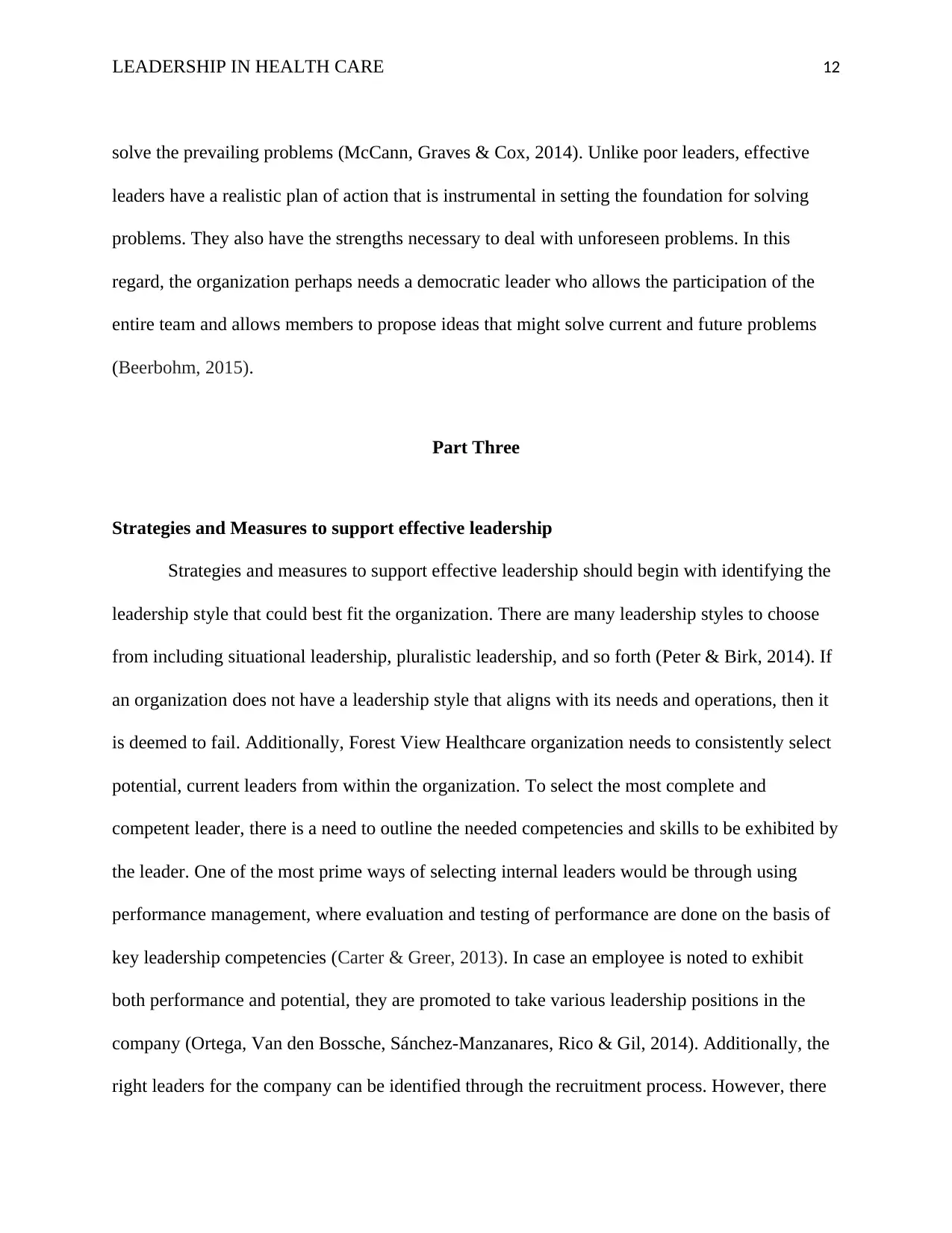
LEADERSHIP IN HEALTH CARE 12
solve the prevailing problems (McCann, Graves & Cox, 2014). Unlike poor leaders, effective
leaders have a realistic plan of action that is instrumental in setting the foundation for solving
problems. They also have the strengths necessary to deal with unforeseen problems. In this
regard, the organization perhaps needs a democratic leader who allows the participation of the
entire team and allows members to propose ideas that might solve current and future problems
(Beerbohm, 2015).
Part Three
Strategies and Measures to support effective leadership
Strategies and measures to support effective leadership should begin with identifying the
leadership style that could best fit the organization. There are many leadership styles to choose
from including situational leadership, pluralistic leadership, and so forth (Peter & Birk, 2014). If
an organization does not have a leadership style that aligns with its needs and operations, then it
is deemed to fail. Additionally, Forest View Healthcare organization needs to consistently select
potential, current leaders from within the organization. To select the most complete and
competent leader, there is a need to outline the needed competencies and skills to be exhibited by
the leader. One of the most prime ways of selecting internal leaders would be through using
performance management, where evaluation and testing of performance are done on the basis of
key leadership competencies (Carter & Greer, 2013). In case an employee is noted to exhibit
both performance and potential, they are promoted to take various leadership positions in the
company (Ortega, Van den Bossche, Sánchez-Manzanares, Rico & Gil, 2014). Additionally, the
right leaders for the company can be identified through the recruitment process. However, there
solve the prevailing problems (McCann, Graves & Cox, 2014). Unlike poor leaders, effective
leaders have a realistic plan of action that is instrumental in setting the foundation for solving
problems. They also have the strengths necessary to deal with unforeseen problems. In this
regard, the organization perhaps needs a democratic leader who allows the participation of the
entire team and allows members to propose ideas that might solve current and future problems
(Beerbohm, 2015).
Part Three
Strategies and Measures to support effective leadership
Strategies and measures to support effective leadership should begin with identifying the
leadership style that could best fit the organization. There are many leadership styles to choose
from including situational leadership, pluralistic leadership, and so forth (Peter & Birk, 2014). If
an organization does not have a leadership style that aligns with its needs and operations, then it
is deemed to fail. Additionally, Forest View Healthcare organization needs to consistently select
potential, current leaders from within the organization. To select the most complete and
competent leader, there is a need to outline the needed competencies and skills to be exhibited by
the leader. One of the most prime ways of selecting internal leaders would be through using
performance management, where evaluation and testing of performance are done on the basis of
key leadership competencies (Carter & Greer, 2013). In case an employee is noted to exhibit
both performance and potential, they are promoted to take various leadership positions in the
company (Ortega, Van den Bossche, Sánchez-Manzanares, Rico & Gil, 2014). Additionally, the
right leaders for the company can be identified through the recruitment process. However, there
⊘ This is a preview!⊘
Do you want full access?
Subscribe today to unlock all pages.

Trusted by 1+ million students worldwide
1 out of 19
Related Documents
Your All-in-One AI-Powered Toolkit for Academic Success.
+13062052269
info@desklib.com
Available 24*7 on WhatsApp / Email
![[object Object]](/_next/static/media/star-bottom.7253800d.svg)
Unlock your academic potential
Copyright © 2020–2025 A2Z Services. All Rights Reserved. Developed and managed by ZUCOL.




